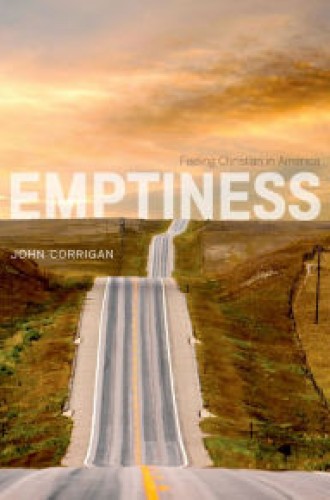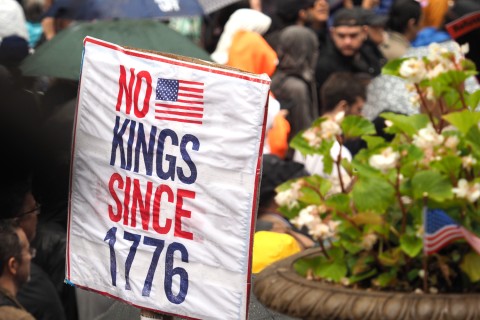Full of emptiness
Emptiness defines much of my life. Often what is not seems to outweigh what is. In my faith I sing to a God I cannot see. I pray without audible words to a Son of God who vanished in the clouds 2,000 years ago. In my profession as a historian, I engage imaginatively with people who no longer live and with organizations that no longer function. Many of the places of the past no longer bear the names they once did. In my heart, I pine for a son whom I can no longer hold. I lived with Elijah for less than one year. It has been three years since we buried him. At Christmas I most notice the presents that are not under the tree. One of the grief groups I attended even bears the name Empty Cradle.
Thanks to historian John Corrigan and his outstanding new book, I now know that American history bursts with such emptiness. When I try to make sense of my Christian tradition; when I try to understand times past, present, and future; and when I sense the palpable anguish of loss, I now see that I am not alone in my experiences of emptiness. As Corrigan shows in his short and evocative walk through American history, I’m part of a deep and wide tradition. For what may seem a dire topic, Corrigan’s history of emptiness is beautifully fulfilling.
Read our latest issue or browse back issues.
Corrigan’s book is not a straightforward or chronological examination of the role of emptiness from the Puritans to the present. Instead, it is a collection of thematic essays on various feelings of emptiness throughout American Christian history. Corrigan has a capacious understanding of the word feeling. By it, he means physical sensation, emotional experiences, perceptions of time and space, thoughts and theology, and any other characteristic of being human. The book makes both feeling and emptiness broader and deeper conceptions than we may usually acknowledge.
Corrigan shines in his ability to mix theme, history, and theory. He performs this magic in each chapter. In one chapter, for instance, he emphasizes overall senses of emptiness, ranging from psychological explanations of emotionally feeling empty to theological considerations of spiritual emptiness. Another chapter fixates on the empty body: Christians at times empty themselves ritualistically of food, blood, or sweat to connect with God. Christians may also sit in silence or abstain from sex in order to have more of the divine. The third chapter focuses on empty space, whether in the form of landscapes, cathedrals, or prayer closets. The “wilderness” of the Puritans, the “Great American desert” of the 19th-century west, and the vaulted ceilings of religious buildings draw attention to absence as a physical space to grow in faith.
Emptiness also contains provocative chapters on the emptiness of time and of faith communities. When considering the subjective and felt natures of time, Corrigan demonstrates that many Christian groups have divided time between the fullness of sacred time and the emptiness of secular time. The everyday is mundane. The everyday can be made full only when it is put into the context of God’s time, and for Corrigan, this is one of the reasons end-times eschatology and considerations of Armageddon have been so popular throughout American history. Obsessing over apocalypse now seems to be a means of securing heaven later.
When it comes to believers and believing communities, Corrigan stresses the terror of words and doctrines that are deemed empty. These can be deceptive and misleading. Empty words can harm individuals, but empty doctrines have the power to pervert entire groups; they are not only to be feared, but also identified and attacked. Corrigan suggests that one of the subtle and sophisticated ways Christian groups establish a sense of in-group solidarity is by identifying others, even others within the same denomination or heritage, as empty enemies. Accusations of emptiness, whether the denunciations are of Catholic ritual or Baptist heresy, can be a potent tool.
In a book with so many splendid features, one of the most obvious is the diversity of Christian traditions Corrigan analyzes. All of the regulars are here: Puritans, Catholics, the legacy of Billy Graham. But Corrigan also includes discussions of Mormons, Jehovah’s Witnesses, and Pentecostals. His source base is just as varied. Corrigan uses sermons, tracts, maps, architecture, novels, and poetry.
Moreover, when Corrigan incorporates race into the narrative, he makes some signal points. For instance, he follows the intrepid work of historian Donald Mathews in recognizing how bodies deemed black have often been made empty to perform religious work for white communities. Lynching victims were either scapegoats or exorcised demons whom whites needed to destroy. Regarding notions of time, Corrigan contends that for African Americans, who often lacked the free time to discuss the biblical apocalypse in highly intellectualized and theoretical ways, tribulation was a constant state of existence. This world and this present time were full enough of evil.
Corrigan throws a lot into the abyss of emptiness. The “wilderness” of colonial Puritan imaginations, for instance, was not exactly empty. It simply had elements that were different from the European background. Even for Puritans this so-called wilderness contained peoples, animals, and crops that were deemed less valuable and in need of redemption. The land was never seen as devoid of presence. Empty words and doctrines, moreover, are not absent words or doctrines. The presence of the empty words and doctrines is the problem. This is both the genius of Corrigan’s study and its slipperiness. Emptiness can alternatively mean too little or too much. It is sometimes unclear where emptiness is distinct from excess.
In the field of American religious history, obsessed as it is with politics and public doctrine, Emptiness is a breath of fresh air. Corrigan draws our attention to personal feelings and everyday practices. Instead of highlighting success or certainty, he plunges into the depths of despair and fluidity. Emptiness touches the core of lived religious experiences in a way that wouldn’t be done by yet another book on the origins of the religious right or the voting patterns of evangelicals before the Civil War.
Corrigan accomplishes much more than helping us to understand how American Christians have experienced emptiness. He does much more than show us how they have put emptiness to work tangibly, intellectually, emotionally, and spiritually. Emptiness provides a fulfilling way to consider our own emptiness. Perhaps it is when we feel most empty that we are most full of our Christianity and our humanity.







